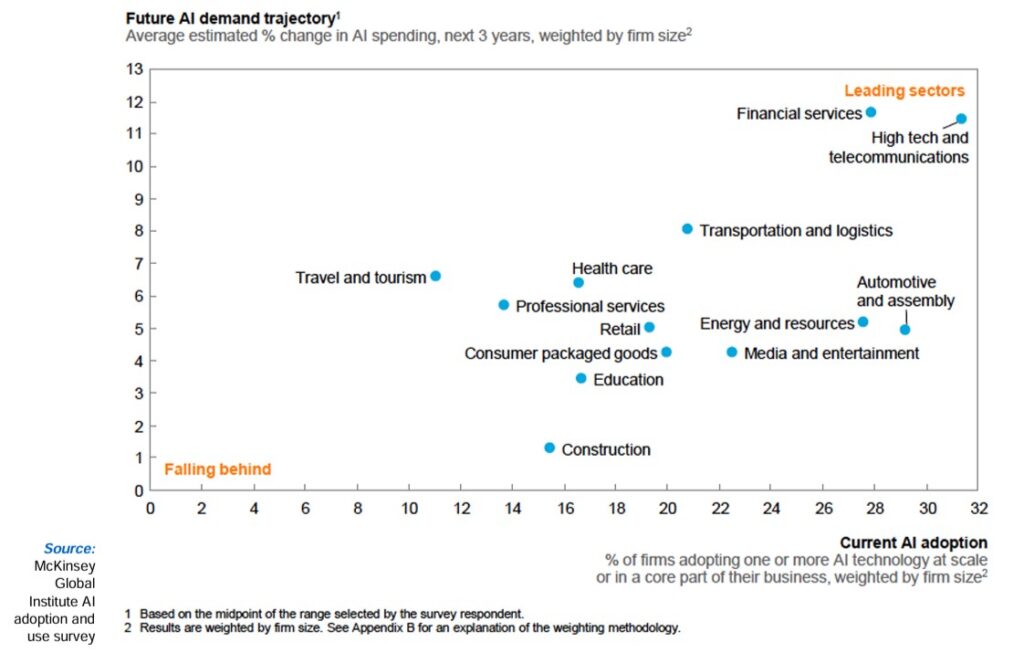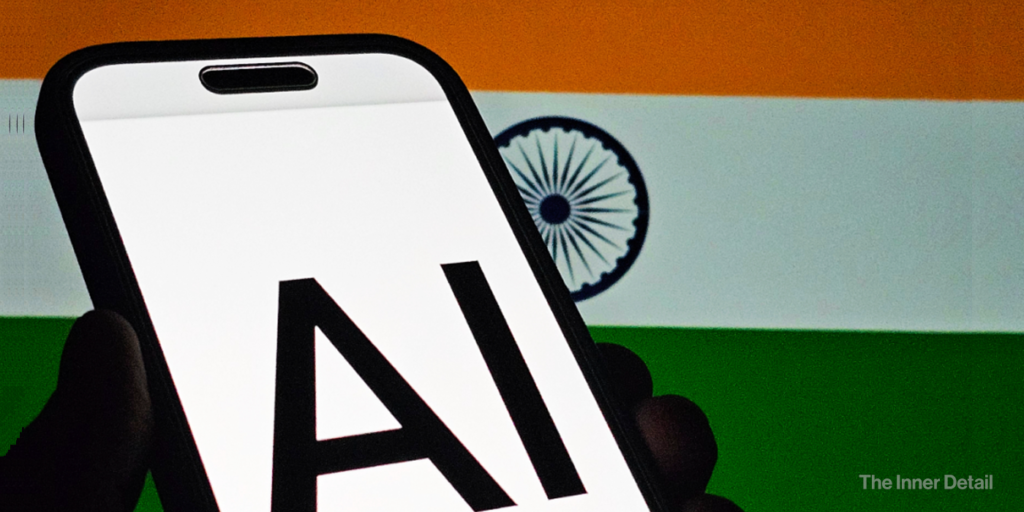At this period in 2024, experts say that India is in the same position as China was, in 2005. Investments in India is surging at a consistent basis and the country is all set to explore and grab the opportunities (investments and technology like AI) as much as it could, being in the sweetest spot in the world economy currently.
When we talk about opportunities in India, two things take a major part in the quantum – one is manufacturing and the second is technology. And in one way or another, manufacturing calls for technological assistance and it attributes mainly to artificial intelligence (AI) as a prime tool in this era. Though AI technology has been existing for several decades, the tech’s presence is profound since the past 2 years, especially after OpenAI announced ‘ChatGPT’.
So, What is AI? Artificial Intelligence, to put it in the simplest way, is an advanced algorithm capable of doing computations which normal computers can’t do. The onset of advanced AI, specifically generative-AI (AI which can create data from prompts, having trained with datasets before) significantly led to the efficiency of a system, wherever it was incorporated. Blending AI into everyone’s life and to every job possible would absolutely create an edge over failing to do that.
And India is striving hard to do so, pushing the companies and people to adopt AI, students to learn AI, and employees to incorporate AI in their workflow system. For this, India is opening wide its gate for investments in AI computing in the country.
But it’s easy to put it in a sentence, rather than bringing it to reality, especially for a populous country like India.
This article hence, will uncover India’s position with respect to
- adaptation of artificial intelligence technology,
- potential, gaps, challenges and opportunities in the adaptation, and
- what the country does for becoming a future leader in AI technology.
The above-mentioned aspects are discussed in five broad sub-topics:
- India’s AI Market
- Future Goals in AI
- India’s Plans to be Future Leader in AI
- The Gap
- AI in Education
You can head to the last section of the page to get to know the key takeaways of this article.
India’s AI Market
Artificial Intelligence industry in India expands rapidly with a CAGR of 28.63% from 2024-2030. India’s AI market is to be worth $8 billion by 2025 and $28.36 billion by 2030. Although the numbers seem attractive, AI market in US – which is expected to be $826 billion – makes it not. Still, India shows a brisk deployment of AI technology across various sectors.
The artificial intelligence technology has the potential to add $1 trillion to India’s economy in 2035, a report by NITI Aayog claims. Sectors like High tech and telecommunications, Banking and Financial services, automotive and assembly are leading the AI adoption as per McKinsey Global Institute’s survey.
Instead of putting it in numbers, let’s see few examples on how India is deploying AI in different sectors and the effective results of it:
- Securities and Exchange Bureau of India (SEBI) implements AI for investigation purposes like approvals, provisions to make the process faster and efficient, it said. Madhari Puri Buch, the current-chairman of SEBI also said that over 80% of the processing work like public documents and reports is done through AI. (Source)
- SBI has been using AI for past couple of years, and now it mulls to build its own domain-specific large language model (LLM), said its Deputy Managing Director Nitin Chugh at Asia Economic Dialogue event. (Source)
- Bengaluru traffic-police launched Bengaluru Adaptive Traffic Control System (BATCS) that uses AI technology to manage traffic in the congested tech-city. (Source). AI indeed helped Delhi’s Police Department too in cracking a murder case. (Source).
And the list goes on. Besides adoption and deployment of AI tools, India remains the birth-place to dozens of AI startups dedicated to provide AI solutions to the customers. In that aspect, India added 174 generative-AI startups in just one year, says Nasscom report. This makes it the 6th country globally in the share of GenAI startup ecosystems among major economies. India is now a home to 240+ genAI startups.
The AI startups in India have attracted over $750 million in cumulative funding since 2023. Bengaluru remains the leading GenAI startup hub in India, housing 43% of all startups. Following it, are the cities like Ahmedabad, Lucknow, Surat and Kolkata.

India’s Future Goals in AI
India is optimistic about its plans in the AI technology, aiming to be the “World Leader” in AI. Is it being over-confident? Or Is the country taking necessary steps to achieve the goal? We’ll discuss this elaborately in the penultimate section of this article, but for now, the country aims bigger with its “IndiaAI” mission.
What is IndiaAI mission? India in is its journey to become a leader in AI technology allocates ₹10,372 Crores ($1.3 billion) for this initiative. The mission focusses on main pillars such as – 1) building dataset platforms, 2) innovation centre, 3) application development centres, 4) future skills, 5) startup financing and 6) focusing on safe and trusted AI.
Nearly half of the fund (₹4,568 Crores) is dedicated for building a cutting-edge compute capacity for the country.
The Innovation Centre will undertake the development and deployment of foundational models, with a specific focus on indigenous LLMs and domain-specific foundational models.
The IndiaAI Application Development Initiative aims to support the development, scaling, and promotion of impactful AI solutions that address real-world challenges. The initiative will source problem statements from Central Ministries, State Departments, and institutions in critical sectors and invite AI researchers, innovators and startups to build, develop and deploy solutions that address the identified challenges.
The India Future Skills pillar aims to enhance India’s AI workforce readiness by mitigating barriers to entry in AI programs and advancing the AI talent pipeline. The pillar will increase AI courses in undergraduate, postgraduate, and Ph.D. programs. Further, it aims to foster inclusive access to AI education by establishing Data and AI Labs in Tier 2 and Tier 3 cities across India to impart foundational level courses.
Under the Startup Financing pillar, the Mission targets to fast-track India’s AI ecosystem through strategic funding support. The pillar aims to foster entrepreneurial growth in AI. With the spirit to enhance India’s AI competitiveness, the pillar will support and accelerate deep-tech AI startups and provide them streamlined access to funding to enable futuristic AI Projects.
India’s Plans to be Future Leader in AI
India understands that the country has to strengthen its supply-side of technology – to create an infrastructure that supports AI adoption, computing, and deployment. In that aspect, India envisions to erect a cutting-edge scalable AI computing infrastructure by deploying over 10,000 graphics processing units (GPU) through strategic public-private collaborations.
It announced a tender for companies to pitch in to procure 10,000 GPUs for building the infrastructure for AI computing in the country. Though the plans seem to be futuristic, it requires pertinent examination of the process and alignment with its long-term objectives.
First of all, the “10,000 GPUs” number itself isn’t really convincing, if compared with global companies’ framework. The computing power that can be achieved with this 10,000 GPUs is considerably low for a big populous country like India. For instance, Meta will have 60x more GPUs than this. And OpenAI required 3640 petaflops of compute to train GPT3 and this 10,000 GPUs translate to just around 25 petaflops.
The Gap
India sees a predominant growth in industries and technology sectors in the country but lags in providing the supply that supports and assists the growth. India has to focus on preparing a workforce who are capable to cater the industrial demand. To put it in a brief way, India has a huge “Industry-Academia” Gap, where the students appearing to the industries aren’t competent enough to take the industrial need of new techs.
In a report by Deloitte India and Nasscom, the demand for AI talent in India is likely to jump to 12,50,000 in 2027 from the current 6,00,000 – 6,50,000. In addition to more demand of 6,00,000 talents, the country also suffers from the quality of the existing professionals to meet the demand. Cumulatively India needs 1 million AI / Data science professionals in the next 5 years.
It added that there is a “pressing need to cultivate a highly skilled AI workforce to propel the country’s digital economy.”
India now has less than 2,000 senior engineers who can build core AI products. And the technology will affect 65% jobs in next 5 years, making a compel need to upskill with AI.
Besides quality workforce, India has few other challenges across different sectors, namely:
- Lack of enabling data ecosystems
- Low intensity of AI research
- Core research in fundamental technologies
- Transforming core research into market applications
- High resource cost and low awareness for adopting AI in business processes
- Unclear privacy, security and ethical regulations
- Unattractive Intellectual Property regime to incentivize research and adoption of AI
These challenges, while by no means exhaustive, if addressed in an expeditious manner through concerted collaborative efforts by relevant stakeholders, with government playing a leading role, could lead to fundamental building blocks that form the core to India’s march towards leadership in AI.
AI in Education
The adoption of technology in education is improving, though not at the pace required. The global education technology market size was at $142.37 billion in 2023 and is expected to reach USD 163.49 billion in 2024.
School education in India, though has seen substantial progress in recent decades, low retention rates and poor learning outcomes mar the impact of gains in the progress. For an instance, in an assessment test conducted for students in rural areas, only 47.8% of Class 5 children could read Class 2 level text and only 26% could do Class-5-level arithmetic.
The urgency to upskill the school students to learn and be compatible with new technologies is inevitable. The reasons explain to be the demand for new techs like AI. India sees a 67% YoY rise in the AI-related jobs in 2024.
Another shocking report by Gartner shows that by 2027, 80% of engineering employees will need to learn new skills to work with AI. This is because AI is changing the way software is developed, and new roles are emerging in the field of software engineering.
While companies have started to upskill their employees to meet the demand, it becomes a compelling factor for India to incorporate technologies like AI in the educational curriculum, at least for the STEM students. Out of 5868 engineering colleges in India, only 1300+ colleges have included AI and AI-related courses.
The country should also encourage startups to work on this perspective for meeting the demand with supply. One of the biggest concerns for India’s growth is now its population – to ensure that everyone is into this growth – to nullify the inequality gap. To address this, there’s a huge need for the Government to pro-actively initiate measures, mainly in terms of upskilling and updating the education curriculum for students.
What do you think as the next biggest challenge for India?
Key takeaways from this article:
- India’s AI Growth: India’s AI market is expanding rapidly, projected to reach $28.36 billion by 2030, with AI having the potential to add $1 trillion to India’s economy by 2035.
- AI Adoption: Various sectors like banking, telecommunications, and law enforcement are embracing AI, while India is now home to over 240 generative AI startups.
- IndiaAI Mission: India aims to be a world leader in AI through its IndiaAI mission, with ₹10,372 crores allocated for building datasets, innovation centers, AI education, and startup financing.
- Infrastructure Gap: Despite ambitious plans, India’s AI infrastructure, including GPU capacity, lags behind global tech giants, signaling a need for more robust infrastructure.
- Talent Shortage: India faces a gap between AI demand and supply, with an urgent need for 1 million AI/data science professionals by 2027 and a lack of senior AI engineers.
- Challenges: Key obstacles include insufficient data ecosystems, low AI research output, resource costs, unclear regulations, and weak intellectual property incentives.
- AI in Education: There is a pressing need to integrate AI into education, especially for STEM students, and address the industry’s skill gap by updating curricula and encouraging upskilling initiatives.






